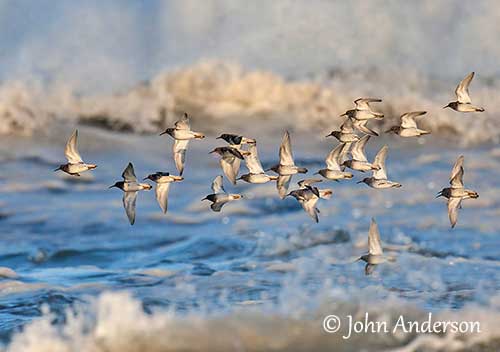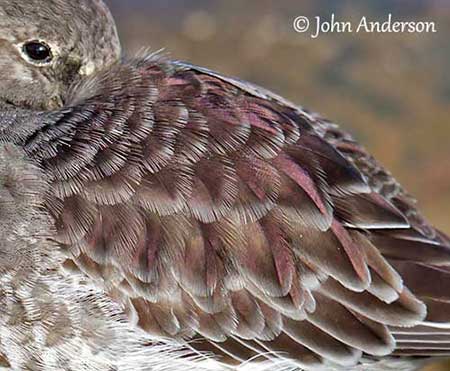
Fr: Bécasseau violet
Ang: Purple Sandpiper
All: Meerstrandläufer
Esp: Correlimos Oscuro
Ita: Piovanello violetto
Nd: Paarse Strandloper
Sd: Skärsnäppa
Photographer:
John Anderson
John Anderson Photo Galleries
Text by Nicole Bouglouan
Sources:
HANDBOOK OF THE BIRDS OF THE WORLD Vol 3 by Josep del Hoyo-Andrew Elliott-Jordi Sargatal - Lynx Edicions - ISBN : 8487334202
SHOREBIRDS by Peter Hayman, John Marchant and Tony Prater – Christopher Helm – 1986 – ISBN: 0747014035
THE HANDBOOK OF BIRD IDENTIFICATION FOR EUROPE AND THE WESTERN PALEARCTIC by Mark Beaman, Steve Madge - C.Helm - ISBN: 0713639601
THE COMPLETE BOOK OF BRITISH BIRDS – Written by “Royal Society for the Protection of Birds” experts - Préface de Magnus Magnusson - Michael Cady- Rob Hume Editors - ISBN: 0749509112
All About Birds (Cornell Lab of Ornithology)
Wikipedia, the free encyclopaedia
What Bird-The ultimate Bird Guide (Mitchell Waite)
Purple Sandpipers breeding in Scotland by Roy H. Dennis
Purple Sandpiper
Calidris maritima
Charadriiformes Order – Scolopacidae Family
INTRODUCTION:
The Purple Sandpiper is a stocky wader of the rocky coasts pounded by the surf. The birds hop or flutter up to escape the incoming water when large waves hit the rocks.
This species breeds in remote areas in Arctic and subarctic regions, and winters on Atlantic coasts of both E North America and W Europe.
The Purple Sandpiper often clambers over rocks, or walks among seaweeds, on beaches and tundra while foraging. Its cryptic plumage blends into its rocky environment.
The name of this bird comes from the glossy purplish edges of upperparts’ feathers.

Despite considerable geographical variation in size, the Purple Sandpiper is monotypic. However, at least four subspecies are proposed, depending on bird size and Arctic range (groenlandica, maritima, littoralis and belcheri). But more study is needed.
DESCRIPTION OF THE BIRD:
Biometrics:
Length: 20-22 cm
Wingspan: 42 cm
Weight: M: 52-94 g – F: 60-105 g
The Purple Sandpiper in breeding plumage has blackish-brown crown, mantle and scapulars, with chestnut and pale fringes. Neck, breast and flanks are heavily streaked brown. The streaks may form a dark patch on the lower breast. Belly and vent are white but streaked with brown on the sides. In flight, the white wingbar contrasts with the dark upperparts, and the white sides of rump and uppertail are conspicuous.
There is a whitish supercilium on the brown head.
The slightly downcurved bill has dull yellow base and blackish tip. The eyes are dark brown. The strong legs and feet are dull yellow. Bill base and legs are tinged with orange in spring.
The female is slightly larger than male and she has longer bill.

The non-breeding adult has blackish-brown head and upperparts with pinkish tips and fringes to feathers on crown, mantle and scapular, visible at close range. Neck and breast show white spots and streaks. The wing-coverts are fringed whitish. We can see a purplish gloss over the back, giving the bird its name.
Bill base, legs and feet are dull yellow, with brownish or greenish tinge on legs.
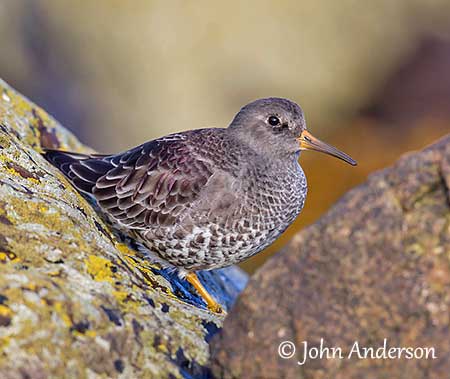
The juvenile resembles breeding adult, but with conspicuous pale chestnut fringes on mantle and scapulars, whereas wing-coverts and tertials have pale fringes. Foreneck and breast are spotted and show a brown-grey wash.
RANGE:
The Purple Sandpiper breeds in NE parts of Arctic Canada, in Greenland, Iceland, Faeroes, Svalbard, N Scandinavia and W parts of Russian Arctic.
This species winters on the coasts of E North America and NW and W Europe.
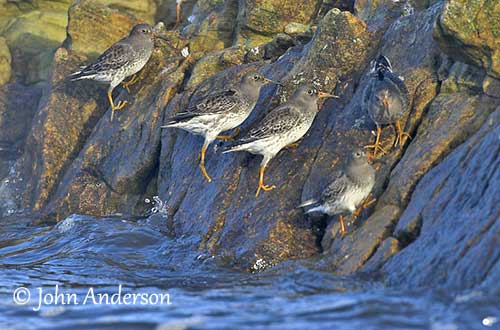
HABITAT:
The Purple Sandpiper breeds on barren northern tundra, and mainly in rocky areas or ridges, and also on rocky islands and islets. On tundra, it can be seen on wet areas with mosses, and on barren rocky areas with scattered patches of lichens and vegetation in upland locations. It also nests among boulders near streams and on shingle beaches.
The birds breeding in high Arctic occur from sea-level up to 300 metres of elevation, whereas in low Arctic and subarctic, it breeds on inland uplands, usually close to snow and ice.
Outside breeding season, it frequents wave-washed rocks and jetties, and rocky shores. It forages in the areas below the high-tide mark, but also among seaweeds on beaches.
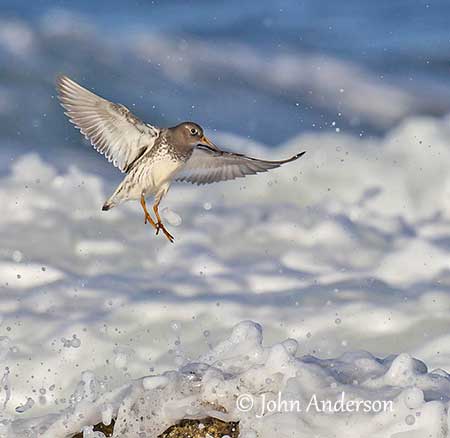
CALLS AND SONGS: SOUNDS BY XENO-CANTO
The Purple Sandpiper is quiet away from the breeding grounds. It gives single or double “whit” or “tit” becoming a low twitter while feeding or roosting in flocks.
The species is more vocal during the breeding season. It utters a variety of buzzing and wheezing trills and low moans during the displays. The song is variable and includes several changes of rhythm.
BEHAVIOUR IN THE WILD:
The Purple Sandpiper feeds primarily on insects and molluscs. During the breeding season, it takes mostly insects, but also crustaceans, spiders and worms. It also feeds on plant material such as berries, buds, seeds and leaves.
During migration and winter, it feeds on small molluscs including mussels and snails, some crustaceans and insects.
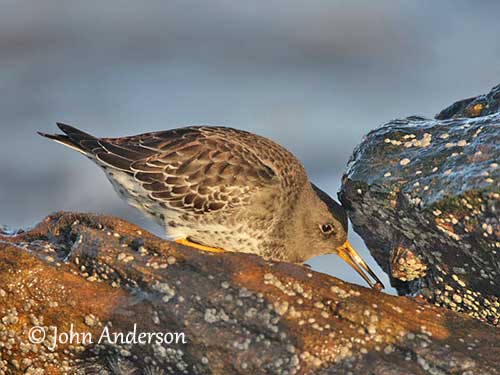
The Purple Sandpiper often forages at fringes of surf. It clambers over rocks and walks among seaweeds on beaches, or searches for food on tundra. It may sometimes probe in mud, but most food is usually found by sight.
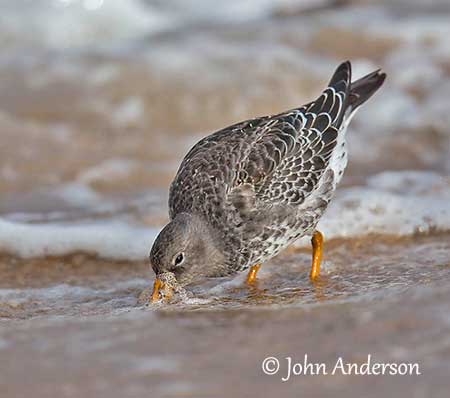
In stormy weather, the Purple Sandpiper can be seen avoiding the waves by hopping. It is fairly gregarious and often occurs in small flocks, sometimes mixed with Ruddy Turnstones. If flushed, it flies low over water.
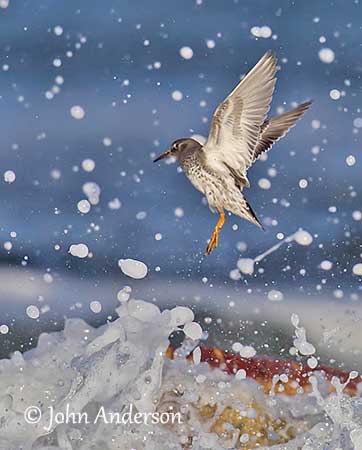
The Purple Sandpiper is territorial during the breeding season. The male performs threat displays from the ground by raising one wing high above its back. It also flies in wide circles with fluttering wings.
During the courtship displays, the male chases the female in the air and on the ground. The flight displays shows the male rising with fluttering wingbeats, gliding and then falling on V-shaped wings. They are monogamous.
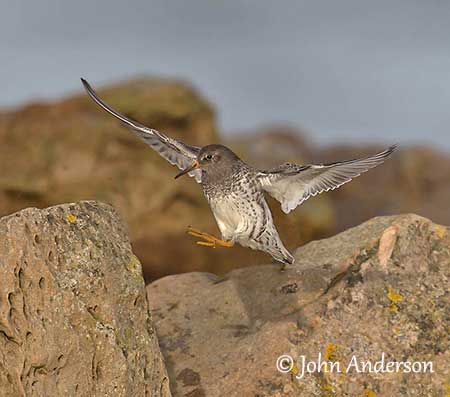
The Purple Sandpiper is migratory or partially migratory according to the range. The adults moult in July/August on coasts near their breeding grounds. They move to their wintering areas between late September and November. The females depart before males and young birds, usually late June.
The return to the breeding grounds occurs in April/May, with arrival in N range mid-May/mid-June.
The Purple Sandpiper flies typically low over water. The flight is direct and fast, with shallow wingbeats.
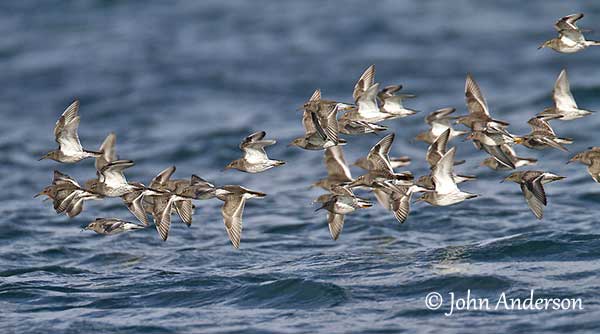
REPRODUCTION OF THIS SPECIES:
The laying varies depending on the range, from mid-May in Faeroes and Iceland, late June in Svalbard and to mid-June/mid-July in Russia.
The Purple Sandpiper is solitary nester and nests in the open. The nest is a shallow depression, a scrape in the tundra moss, sometimes lined with plant material. This species may nest in high rocky area or lower wet sites, but usually among mosses and lichens. The male prepares up to five nest scrapes, and the female selects one.
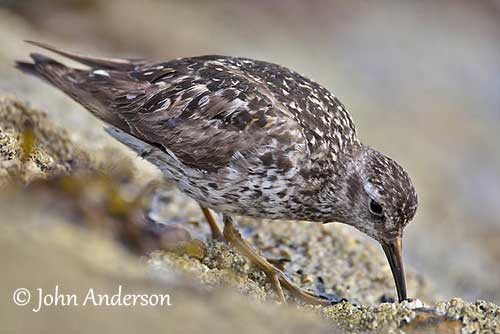
She lays 3-4 olive-buff eggs with brown markings. Both adults incubate during about three weeks, but the male takes major share in incubation. At hatching, the chicks are black above with cinnamon mottling and white specks. The underparts are paler, pale greyish to white. They are precocial and feed themselves very soon after hatching. Both parents tend the brood, but the female usually deserts just before or after hatching, and the male rears the chicks alone. The young fledge 21-24 days after hatching. They usually breed at 1-2 years old.
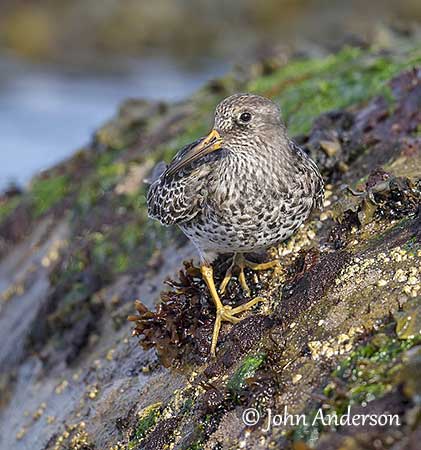
PROTECTION / THREATS / STATUS:
The Purple Sandpiper has stable populations and this species is not globally threatened. The global population has not been quantified, but there are several thousands of birds throughout the range. The Purple Sandpiper is currently evaluated as Least Concern.
